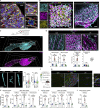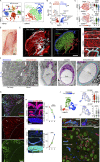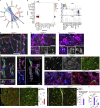CD163+ macrophages monitor enhanced permeability at the blood-dorsal root ganglion barrier
- PMID: 38117255
- PMCID: PMC10733632
- DOI: 10.1084/jem.20230675
CD163+ macrophages monitor enhanced permeability at the blood-dorsal root ganglion barrier
Abstract
In dorsal root ganglia (DRG), macrophages reside close to sensory neurons and have largely been explored in the context of pain, nerve injury, and repair. However, we discovered that most DRG macrophages interact with and monitor the vasculature by sampling macromolecules from the blood. Characterization of the DRG vasculature revealed a specialized endothelial bed that transformed in molecular, structural, and permeability properties along the arteriovenous axis and was covered by macrophage-interacting pericytes and fibroblasts. Macrophage phagocytosis spatially aligned with peak endothelial permeability, a process regulated by enhanced caveolar transcytosis in endothelial cells. Profiling the DRG immune landscape revealed two subsets of perivascular macrophages with distinct transcriptome, turnover, and function. CD163+ macrophages self-maintained locally, specifically participated in vasculature monitoring, displayed distinct responses during peripheral inflammation, and were conserved in mouse and man. Our work provides a molecular explanation for the permeability of the blood-DRG barrier and identifies an unappreciated role of macrophages as integral components of the DRG-neurovascular unit.
© 2023 Lund et al.
Conflict of interest statement
Disclosures: Z. Kurtović reported “other” from Kancera AB (PhD salary) during the conduct of the study. J.H. Graversen reported being a minor shareholder of OncoSpear ApS that develops CD163 antibodies for the treatment of cancer. No other disclosures were reported.
Figures














References
-
- Andreone, B.J., Chow B.W., Tata A., Lacoste B., Ben-Zvi A., Bullock K., Deik A.A., Ginty D.D., Clish C.B., and Gu C.. 2017. Blood-brain barrier permeability is regulated by lipid transport-dependent suppression of caveolae-mediated transcytosis. Neuron. 94:581–594.e5. 10.1016/j.neuron.2017.03.043 - DOI - PMC - PubMed
MeSH terms
Grants and funding
LinkOut - more resources
Full Text Sources
Molecular Biology Databases
Research Materials

